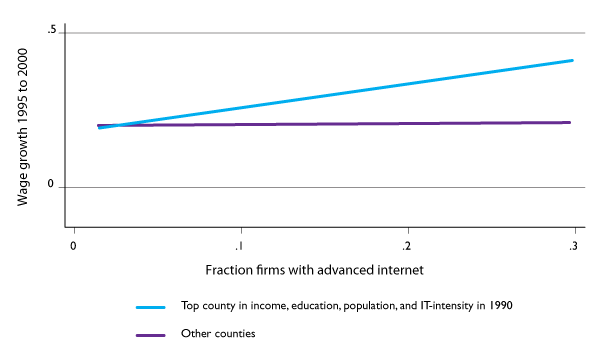What has the Internet Done for the Economy?
by CFI | November 3, 2012 10:57 am
The puzzling spread of the commercial Internet could explain wage inequalities.
By Virginia Hughes. Based on the research of Christopher Forman, Avi Goldfarb and Shane Greenstein.
 It is hard to overstate how much the business world relies on the Internet. Powerhouse retailers like Target and Wal-Mart can simultaneously manage their changing inventories, warehouses, distribution routes, and sales. FedEx and UPS can code every shipment online so that customers can find out exactly where their packages are and what time they will arrive at their doors. Buying a wedding gift? Just pull up the couple’s online registry and browse the items that have not been purchased yet. Shopping for insurance? You can get quotes quickly via secure online chats with company representatives.
It is hard to overstate how much the business world relies on the Internet. Powerhouse retailers like Target and Wal-Mart can simultaneously manage their changing inventories, warehouses, distribution routes, and sales. FedEx and UPS can code every shipment online so that customers can find out exactly where their packages are and what time they will arrive at their doors. Buying a wedding gift? Just pull up the couple’s online registry and browse the items that have not been purchased yet. Shopping for insurance? You can get quotes quickly via secure online chats with company representatives.
None of that was possible before 1995, when the large, government-controlled networks somewhat begrudgingly opened their lines for commercial use. Advanced Internet technologies spread rapidly in businesses across the country—in small cities, sprawling suburbs, and dense urban hubs. Although this sparked wage and employment spurts everywhere, the gains were far more striking in regions that were already well off, according to a study to appear in the American Economic Review.
“The tide was rising, with everyone’s boats going up, but the boats went up more in a small number of cities,” says Shane Greenstein, professor of management and strategy at the Kellogg School of Management and lead investigator of the new work. The explanation for this surprising pattern is still being worked out, but Greenstein suspects it was because more prosperous cities were home to sophisticated companies that knew how to best take advantage of the new technology. “It was enhancing the stuff they were already doing, and they got a very dramatic improvement,” he says.
Greenstein and collaborators Chris Forman, an associate professor at the Georgia Institute of Technology, and Avi Goldfarb, an associate professor at the University of Toronto, have been studying the economics of the Internet for a decade. In their early work, they analyzed how the early Internet spread through U.S. businesses. Some of their findings were wholly unexpected. For example, in the late 1990s businesses everywhere adopted basic Internet services, such as email and web browsing. This was surprising because home use of these technologies showed fairly stark urban-rural divides.
Adoption patterns were more predictable for advanced technologies, such as inventory management systems and online database sharing. Such technologies were more likely to crop up in larger cities than smaller ones, and in data-heavy industries, such as finance and wholesale distribution, than in manufacturing, mining, and social service industries. “It makes sense—you just don’t find advanced Internet at nursing homes,” Greenstein says, laughing.
About three years ago, the trio began researching how this intriguing distribution of the Internet affected the economy. There is widespread optimism among media commentators and policy makers that the Internet erases geographic and socioeconomic boundaries. The Death of Distance and The World Is Flat, two books that espouse that rosy view, were bestsellers. But in the early days of the Internet, the income gap between the upper and middle classes actually began to grow. “We thought it was just a very natural question to ask: is the Internet responsible?” Greenstein says.
“The tide was rising, with everyone’s boats going up, but the boats went up more in a small number of cities.”
Misplaced Optimism
The researchers studied trends from 1995 to 2000 in several large sets of data, including the Quarterly Census of Employment and Wages—which gives county-level information on average weekly wages and employment—and the Harte Hanks Market Intelligence Computer Intelligence Technology Database, which holds survey information about how firms use the Internet. In total, the researchers included relevant data for nearly 87,000 private companies with more than 100 employees each. Based on their older work, they focused only on advanced Internet technologies.
Out of about 3,000 counties in the U.S., in only 163 did business adoption of Internet technologies correlate with wage and employment growth, the study found. All of these counties had populations above 150,000 and were in the top quarter of income and education levels before 1995. Between 1995 and 2000, they showed a 28 percent average increase in wages, compared with a 20 percent increase in other counties (Figure 1).
 [1]
[1]Figure 1. Advanced Internet investment and wage growth by county type.
Why did the Internet make such big waves in these few areas? Greenstein believes the reason was that these areas already had sophisticated companies and the communications infrastructure needed to seize on the Internet’s opportunities. But there are other possibilities. The impact could have been due to a well-known phenomenon called “biased technical change,” which means that new technologies can thrive only in places with skilled workers who know how to use them. Or it could have been because cities brought certain advantages—denser labor markets, better communication, tougher competition—than more remote areas.
“Each one of those explanations is plausible in our data, and probably explains a piece of it. But none of them by themselves can explain the whole story,” Greenstein says. “It’s really a puzzle.”
Regardless of why the pattern crops up, it has important implications for public policy. Many lawmakers have argued for government to subsidize the expansion of the Internet into poor and isolated regions. In fact, the 2009 economic stimulus package allocated over $7 billion for broadband expansion. “In policy conversations, there’s a very common presumption that technology is good, that it will raise wages and income,” Greenstein says. “But since doing this work, I’ve become much more of a skeptic about the economic side of that argument.”
He says that these efforts could be justified for other reasons—such as strengthening education, increasing civic engagement, and promoting health and safety. And over 20 to 30 years, expanding the Internet could lead to economic gains. But in the short term, he says, “I am no longer confident it will make a big economic improvement.”
He hopes this research inspires others to analyze similar data from more recent years. It is possible that the patterns from the late 1990s will not hold up. Today almost all medium and large-size establishments use broadband and targeted Internet advertising, and the U.S. economy depends more on outsourcing and has a less robust manufacturing industry. And the last two years, of course, have seen an economic collapse that has hit the country unevenly, for reasons that are not entirely understood. “It’s just a very different economy now,” Greenstein says. “As a consequence of that, I’m really not sure what we’ll find.”

Reproduced with permission of the Kellogg School of Management and Kellogg Insight, http://insight.kellogg.northwestern.edu[2]. © Kellogg School of Management at Northwestern University.
- [Image]: https://cfi.co/wp-content/uploads/2012/11/Greenstein.gif
- http://insight.kellogg.northwestern.edu: http://insight.kellogg.northwestern.edu
Source URL: https://cfi.co/finance/2012/11/what-has-the-internet-done-for-the-economy/